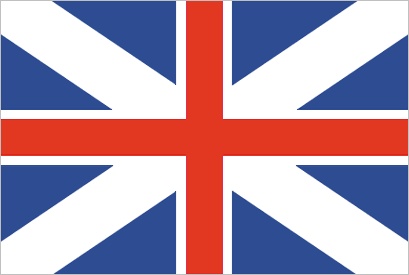United Kingdom, flag of the
Flag History
also called (commonly) Union Jack or (formally) Union Flag

red, white, and blue flag (United Kingdom) in which are combined the Crosses of St. George (England), St. Andrew (Scotland), and St. Patrick (Ireland). Initially the flag was called a jack only when it was flown at the bowsprit of British naval vessels. It was commonly called the Union Jack by the late 17th century, and that name became official in the late 19th century. The Union Jack is flown on land for government and military purposes, and at sea it serves as a flag for the Royal Navy. The general public uses it unofficially as a civil flag. Its width-to-length ratio is 1 to 2.
 The earliest form of the flag of Great Britain, developed in 1606 and used during the reigns of James I (1603–25) and Charles I (1625–49), displayed the red cross of England superimposed on the white cross of Scotland, with the blue field of the latter. Because in heraldry a red on blue is not considered permissible, the red cross had to be bordered with white, its own correct field. During the Commonwealth and Protectorate period (1649–60), the Irish harp was incorporated in the Union Jack, but the flag resumed its original form on the Restoration of Charles II in 1660. Thus did the “Union Flag,” or “Great Union,” continue in use until January 1, 1801, the effective date of the legislative union of Great Britain and Ireland. In order to incorporate the Cross of St. Patrick (a red diagonal cross on white) while preserving the individual entities of the three crosses, the heraldic advisers to the sovereign found an elegant solution. The existing white Cross of St. Andrew was divided diagonally, with the red appearing below the white on the hoist half of the flag and above it on the fly half. To avoid having the red cross touch the blue background, which would be contrary to heraldic law, a fimbriation (narrow border) of white was added to the red cross. In the centre, a white fimbriation also separated the Cross of St. Patrick from the red Cross of St. George.
The earliest form of the flag of Great Britain, developed in 1606 and used during the reigns of James I (1603–25) and Charles I (1625–49), displayed the red cross of England superimposed on the white cross of Scotland, with the blue field of the latter. Because in heraldry a red on blue is not considered permissible, the red cross had to be bordered with white, its own correct field. During the Commonwealth and Protectorate period (1649–60), the Irish harp was incorporated in the Union Jack, but the flag resumed its original form on the Restoration of Charles II in 1660. Thus did the “Union Flag,” or “Great Union,” continue in use until January 1, 1801, the effective date of the legislative union of Great Britain and Ireland. In order to incorporate the Cross of St. Patrick (a red diagonal cross on white) while preserving the individual entities of the three crosses, the heraldic advisers to the sovereign found an elegant solution. The existing white Cross of St. Andrew was divided diagonally, with the red appearing below the white on the hoist half of the flag and above it on the fly half. To avoid having the red cross touch the blue background, which would be contrary to heraldic law, a fimbriation (narrow border) of white was added to the red cross. In the centre, a white fimbriation also separated the Cross of St. Patrick from the red Cross of St. George.The Union Jack is the most important of all British flags and is flown by representatives of the United Kingdom all the world over. In certain authorized military, naval, royal, and other uses, the Union Jack may be incorporated into another flag. For example, it forms the canton of both the British Blue Ensign and the British Red Ensign. It is part of the flags of such Commonwealth nations as Australia (Australia, flag of), New Zealand (New Zealand, flag of), and Tuvalu (Tuvalu, flag of), as well as of the U.S. state of Hawaii (Hawaii, flag of), the Australian states (New South Wales (New South Wales, flag of), Queensland (Queensland, flag of), South Australia (South Australia, flag of), Tasmania (Tasmania, flag of), Victoria (Victoria, flag of), and Western Australia (Western Australia, flag of)), and three Canadian provinces (British Columbia (British Columbia, flag of), Manitoba (Manitoba, flag of), and Ontario (Ontario, flag of)).
- Na-Dené languages
- Nader, Ralph
- Nadezhda Konstantinovna Krupskaya
- Nadia Boulanger
- Nadia Comăneci
- Nadiad
- Nadia Nerina
- Nadi brothers
- Nadig, Marie-Thérèse
- Nadine Gordimer
- Nador
- Naestved
- Naevius, Gnaeus
- Nafūd, An-
- Nafūsah Plateau
- Naga
- naga
- Nagai Kafū
- nagana
- Nagano
- Nagano Osami
- Nagaoka
- Nagaon
- Nagappattinam
- Nagarjuna